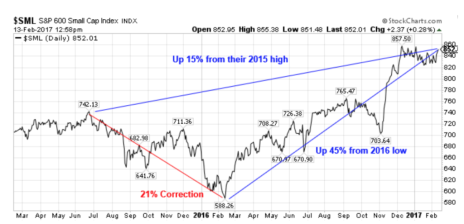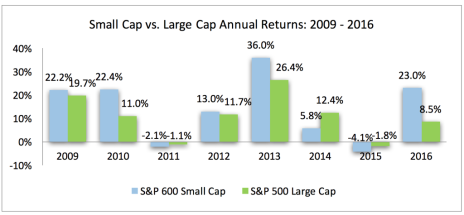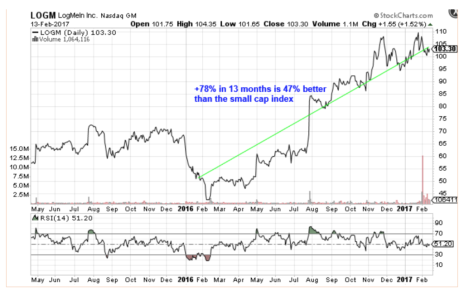First, Ignore the Noise
At the beginning of every year, I try to zero in on the big picture trends that I think will drive small-cap performance (or lack thereof) over the next 12 months. It’s a good exercise since it forces me to dig into data that I might not otherwise devote as much attention to given my everyday focus on individual small caps. It also forces me to try to put the current state of the small-cap market into the broader context of market performance over many years and economic cycles.
This year, it’s been especially difficult to come up with a 12-month outlook given the degree of uncertainty after the U.S. Presidential election. Yesterday, I received an email from The Week with a subject line that just about sums it up: The Exhausting Donald. How do you stay focused on the big picture when a Tweet or off-hand comment drives daily stock market direction?
The obvious answer is that you try to ignore the noise and focus on what matters most. Let’s do that right now and talk about where small caps are today, discuss them in the context of a multi-year bull market, and consider five reasons why small caps could outperform again in 2017.
Small Caps Rallied 23% in 2016
Let your mind wander back to mid-February 2016. We were experiencing a global growth scare. U.S. equity markets had just nosedived. Small caps were down 17% since the beginning of December 2015, and were down 21% from their June 2015 peak.
[text_ad]
But valuations looked great. And once Q4 2015 earnings started to be released in February 2016, it became abundantly clear that the market had dramatically overreacted to concerns about growth.
You know what happened next. The market rallied for six months, sending small caps up 30%. A mini-correction carried us into the election and then the real fireworks began. When 2016 was finally in the books, small caps had posted a calendar year gain of 23% (large caps were up 8.5%). That was far better than most analysts had expected, including me (I had forecast a 15% gain for small caps). But as impressive as that run was (small caps are now up 45% from their February 2016 low), small caps are still only 15% above their June 2015 high.
This brings me to the simplest reason why small caps could outperform again in 2017.
Reason #1: One Year of Small Cap Outperformance Isn’t a Trend
This is just a restatement of the old market adage that bull markets don’t die from old age. Or put another way, trends often persist for longer than expected. Small-cap outperformance isn’t yet a trend. While there’s nothing magical about analyzing calendar-year returns, the method does show that in recent history, small-cap outperformance tends to run in twos—the asset class outperformed (and delivered positive returns) in 2009 and 2010, then again in 2012 and 2013. There’s no reason why it can’t go back-to-back in 2016 and 2017. This is admittedly a rudimentary way of looking at things. But sometimes that perspective is valuable, especially when many of the reasons small caps rallied at the end of 2016 are expected to play out in 2017 and 2018. Let’s discuss those.
Reason #2: Small Caps Outperform During Economic Expansions
This is a carry-over trend from last year when I expected small cap stocks would get a lift from GDP growth. The same goes for 2017, but the growth outlook is even better now. Many analysts are forecasting 2017 GDP growth in the 2% to 3% range. That’s the zone of growth that tends to correlate with strong equity performance. Data from Credit Suisse shows that since 1979, GDP growth in the 2% to 3% range has resulted in small caps being up 88% of the time, and outperforming large caps 75% of the time. Since 1986, small caps have been up 100% of the time when GDP growth is in the 2% to 3% range, and they’ve outperformed large caps 86% of the time. In other words, it hasn’t paid to bet against small caps when GDP growth is in the 2% to 3% range.
Reason #3: Small Caps Should Benefit from Protectionist Policies Due to High U.S. Exposure
Investing in small caps is like a leveraged play on the U.S. economy. That’s because around 80% of small-cap sales come from within the U.S. In comparison, around 31% of large cap (S&P 500) revenues come from the U.S. There are a lot of variables to factor into a full-blown analysis of a pro-U.S. agenda, mainly the potential negatives of taking such an agenda so far that it alienates the U.S. But assuming such an agenda isn’t pushed over the line, protectionist policies should help small caps in 2017.
Reason #4: Rising Interest Rates Are (Still) Good for Small Caps
This is another carry-over from 2016 given that it was such a hot topic last year, and that the Fed raised rates for the first time in almost a decade in December 2016. That event was likely the beginning of a trend of rising rates, although the precise timing and pace is up for debate. The Fed could easily be holding off on any more decisions to see if Trump makes progress on infrastructure spending and corporate tax cuts, both of which could lead to a faster hiking cycle. What isn’t debatable is that four decades of data show that rising rates have been good for small caps, not only in absolute turns (generating higher returns than in falling rate environments) but also in relative terms (generating higher returns than large caps).
Data from Fidelity (going back to 1979) suggests small cap stocks enjoy an average 12-month gain of 14% when long-term rates rise by 1%. And when short-term rates rise by 1.2%, small caps average a 12-month return of 15%. Stocks, including small cap stocks, tend to go down before they go up after the first hike. But that part of the cycle is most likely already behind us.
Reason #5: A Corporate Tax Cut Would Be Disproportionally Beneficial to Small Caps
If Trump is able to push a lower corporate tax cut through Washington, small caps should benefit. It’s estimated that the effective tax rate of the Russell 2000 is 32%, versus 26% for the S&P 500. That’s a big difference, and those small companies would most likely pour that money into dividends, stock buybacks, M&A or rainy day funds. In just about any scenario, share prices should react favorably, at least initially. The last major tax relief was enacted with the passage of the Tax Reform Act on October 22, 1986. And while there were some stock market bumps in the road afterward, most notably Black Monday (October 19, 1987), the broad market increased by nearly 50% by the time Bush’s Omnibus Budget Reconciliation Act of 1990 was passed, effectively raising individual income tax rates on November 5, 1990.
A Word About Small Cap Valuations
Small-cap valuations are one of my biggest concerns. With the S&P 600 trading at 19.5-times forward earnings, there’s not a lot of upside to valuations before we get seriously overheated. And history shows that when small caps trade with a forward P/E of around 20, upside is capped.
There is one thing to consider, however, which might justify a historically high P/E ratio. In the words of Goldman Sachs (they refer to large caps, but the same logic applies to small caps): “Here, it’s helpful to remember that the S&P 500’s long-term average P/E ratio— which many investors use to gauge fair value—was forged over a period when risk-free rates averaged 4.5%. In contrast, the risk-free rate now is just 0.5%-0.75% and the Federal Reserve estimates its new long-run equilibrium level has fallen to 3%, a full 1.5 percentage points below the historical average. Of equal importance, the Federal Reserve is not expected to reach that 3% target for six years…”
In other words, an extended low-interest rate environment is an anomaly, and could help validate an extended period of historically high valuations. With other investment options—bonds, cash, even hedge funds—not expected to do better than equities, where’s the real motivation to move away from stocks?
High though valuations might be, the lack of a next-best alternative is a major reason to stick with stocks. And that, along with just enough logic to support high valuations coupled with real GDP growth, revenue and EPS growth, and the potential for tax reform, might mean we shouldn’t be overly concerned about valuations. I don’t think we’re going to see small caps up over 20% again in 2017. But I can foresee a scenario in which they could rise 5% to 10%.
These Stocks Are Beating the Small Cap Index by 10%
As in any year, there are likely to be pullbacks and corrections. Spring and summer has historically been a time of market volatility, and I can foresee a culmination of events driving another bout this year. But history has shown that investors that try to get too cute with timing their trades get chewed up and spit out like discarded gum. I find a better approach than trying to time broad market moves is to time stock-specific moves and be an opportunistic buyer and seller. That’s one of the strategies I employ in Cabot Small-Cap Confidential, and it’s helped our average position outperform the small cap index.
One example was LogMeIn (LOGM), a software stock I recommended in January 2016 just after it had fallen 28%. At the time, it was larger than most small caps I cover. But it I felt it was appropriate given the broad market’s weakness and stock-specific growth catalysts. It worked out, and subscribers are now sitting on a 78% gain.
The reality is that we can’t anticipate major market swings with any repeatable accuracy. But we can have better success anticipating individual stock swings by focusing on company fundamentals, growth catalysts, business models and stock trading patterns—not to mention the big picture trends that should drive overall equity performance.
By heeding the trend of small-cap outperformance over the long-haul, maintaining the perspective of the current investing environment, and using time-tested strategies to find the best small caps to deliver outperformance without taking on undue risk, I think investors can have a profitable 2017. If you think so too, and want to join a small group of subscribers that are beating the market right now, you should grab a subscription to Cabot Small-Cap Confidential. Click here now to sign up.
[author_ad]



